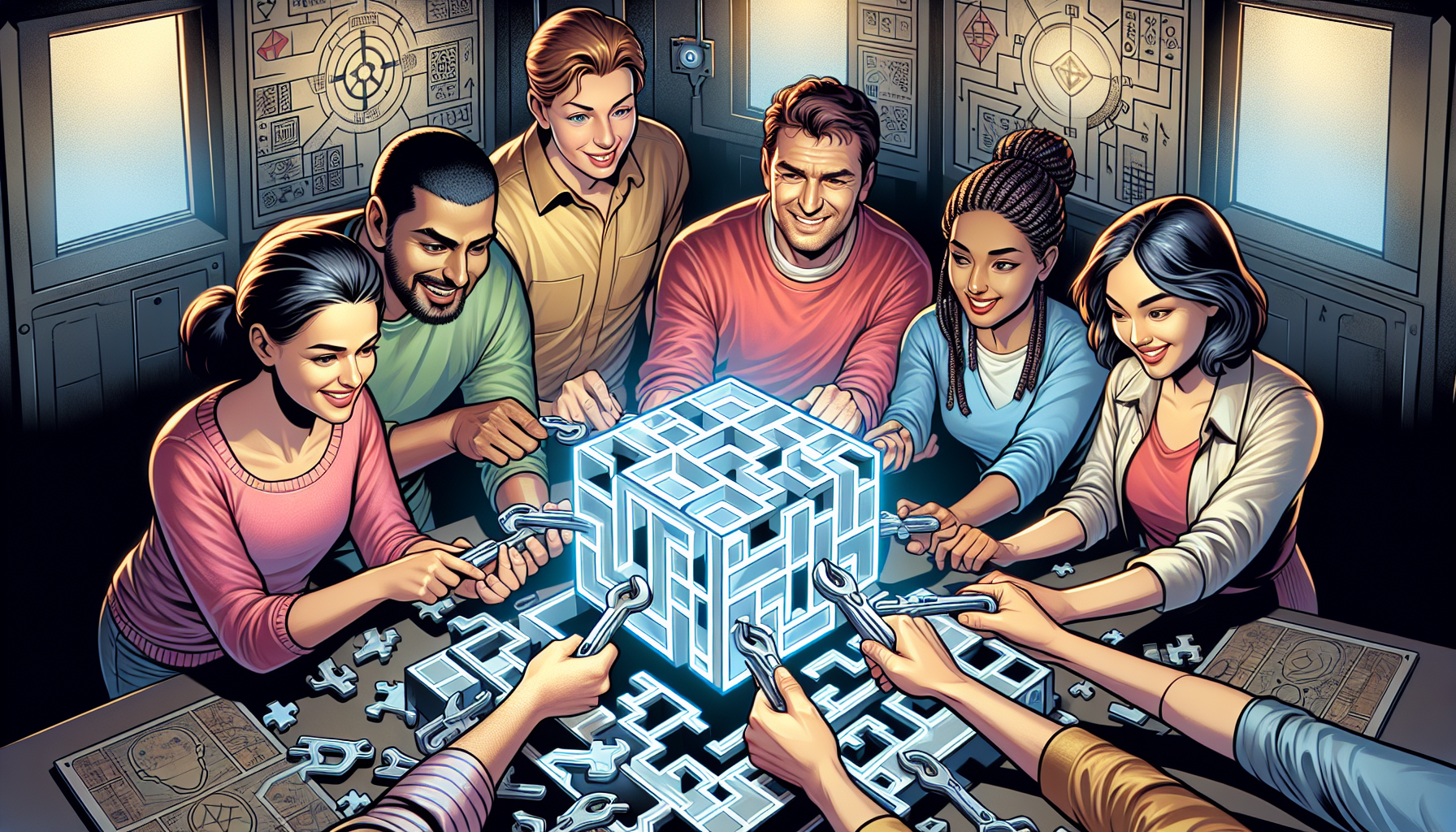Ingenious DIY Escape Room Puzzle Ideas for Thrilling Adventures at Home
Want to craft an escape room puzzle that captivates and challenges? Our article DIY puzzle ideas arm you with the secrets to turn any room into an immersive escape game. Tackle everything from logic tests to physical tasks, creating a journey that’s memorable and demanding. Prepare to unlock the power of play and teamwork with puzzles designed to delight.
Key Takeaways
- Escape room puzzles are diverse and engaging, ranging from math and word puzzles to finding hidden items and cracking combination locks, requiring players to sift through distractions and engage in logic and strategy.
- Creative clue crafting adds layers of intrigue to escape rooms, employing hidden messages, secret compartments, and ciphers that are woven seamlessly into the game’s theme, providing an immersive and clandestine experience.
- Physical and sensory challenges enhance the immersive aspect of escape rooms by engaging a range of senses and demanding both mental and physical participation, while teamwork-focused puzzles emphasize the importance of collaborative problem-solving.
Unlocking the Fun: Escape Room Puzzle Basics

Have you ever wondered what makes escape rooms so irresistibly engaging? It’s the heart-pounding variety of escape room puzzles that whisk players away on a cerebral adventure. From the young to the young-at-heart, escape room puzzles offer a wide range of challenges, including:
- Math challenges that tickle the intellect
- Word games that tease the tongue
- Discovery of hidden clues within ordinary objects
- Traditional tasks like hunting for keys or combinations
These puzzles keep players on their toes and provide the thrill of discovery.
Puzzles are the glue that binds an escape room together, setting the pace and guiding players through a tapestry of tasks. They’re icebreakers, navigators, and the ultimate test of your sorting and sequencing skills, all wrapped in one. The joy lies in the journey from one puzzle to the next, each a stepping stone leading to that final, triumphant discovery.
Adding a layer of sophistication, escape room puzzles dare players to engage in a variety of escape room puzzle ideas that challenge them to:
- sift through the intentional and the irrelevant
- see each clue as a piece of a larger picture
- recognize distractors as false strokes in the canvas of the game
- engage in a dance of logic and strategy
- calculate every move
- be surprised by every revelation waiting to unfold.
Then there’s the rush of cracking a combination lock, the quintessential escape room challenge. It’s a test of deduction, a moment of tension, as players scramble to find the numbers that will release the next secret and propel the game forward.
As we unlock the fundamentals of escape room puzzles, let’s delve deeper into the art of cryptic communication. How do you craft an escape room clue that is as invisible as it is integral? The next segment of our adventure reveals the secret message behind creating such clues.
Creative Clue Crafting: Hidden Messages and Codes

What’s an escape room without a touch of the clandestine? Think invisible ink that only shows its secrets under the glow of UV light, or when submerged in water – the excitement of such hidden messages is unparalleled. It’s not just about what you hide, but how you hide it, making the discovery all the more satisfying.
Ciphers are the lock picks of the escape room world, and the variety is as rich as history itself. From the simplicity of a Caesar Cipher to the complexity of a Vigenere/Grid Code, each coded message is a tantalizing tangle of intellect and intrigue.
Imagine players’ delight as they:
- Swap symbols
- Decode messages
- Solve puzzles
- Uncover hidden clues
Each solution brings them a step closer to the grand finale.
The design of secret compartments can turn the most mundane of objects into treasuries of clues. A vase, a book, or even a hollowed-out candle can become the most sought-after item in the room, as players search for the next clue that will lead them to freedom. In this game of wits, a locked box may hold the key to solving the mystery.
And when these elements align with a theme – detective work, historical conspiracies – the room comes alive with an atmosphere thick with mystery. Tiny text for detectives or extracted secret messages for spies, each hidden message is a thread in the intricate fabric of the game’s universe.
As we craft clues with the stealth of a spy and the cunning of a detective, we turn to the realm of sights and sounds. How can visual and audio elements not only enhance the escape room experience but become central to the puzzle itself? Let’s illuminate the possibilities in the next chapter of our escapade.
Lights, Camera, Puzzle: Incorporating Visual and Audio Elements

Visual and audio cues are the hidden stars of any great escape room puzzle. Imagine the intrigue as lasers reveal messages previously unseen, and shadows cast by strategic lighting whisper secrets to those who interpret them correctly. It’s a play of light and darkness, a game where vision is both ally and adversary.
The auditory aspect is no less enthralling. Sound puzzles envelop players in a symphony of clues, where a keen ear can discern the path forward from the discordant noise. It’s a challenge that dances on the edge of perception, where every note might hold the key to the next stage of the game.
Moving pictures have a charm all their own. Video messages can transport players to different realms, convey intricate backstories, and embed clues in the blink of an eye or the turn of a phrase. They’re not just a means to an end but an essential piece of the storytelling puzzle.
And let’s not forget the digital dimension. Today’s escape room puzzles often integrate technology in ways that are both innovative and intuitive. From USB sticks laden with enigmas to a laser maze that demands precision and poise, each digital device is a gateway to the next revelation.
As we traverse the digital and physical realms of visual and auditory puzzles, we must remember that it takes more than a solo hero to conquer an escape room. It requires a band of brothers and sisters, a fellowship of minds and talents. How do we design puzzles that not only encourage but necessitate collaboration? Our next segment dives into the cooperative heart of escape gaming.
Teamwork Makes the Dream Work: Puzzles that Encourage Collaboration

In the world of escape rooms, no one goes it alone. Picture a pair of players, each controlling a different section of a maze puzzle, their movements restricted, their goal singular – to reach that key or object that lies just beyond their individual reach. It’s a dance of coordination, a test of togetherness.
Tools like magnets on strings or grabby devices become extensions of the players themselves, requiring a harmony of action to retrieve the objects that lie just out of reach. It’s a physical metaphor for the power of cooperation, a reminder that many hands make light work.
Simultaneous actions, such as pressing buttons or placing items in the correct sequence, can’t be accomplished alone; they demand the concerted effort of multiple team members. These tasks are not just about problem-solving but about synchronizing, about finding the rhythm in the chaos.
Even the act of assembling or arranging everyday objects becomes a group endeavor in an escape game, as escape room players collectively discover the hidden code or message within. The escape room becomes a canvas, and the players are the artists, each contributing to the creation of a masterpiece.
Communication is at the heart of these collaborative puzzles. Take the ‘minefield’ challenge, where blindfolded players navigate a landscape of obstacles with only the voices of their teammates as their guide. It’s a testament to the power of words and the strength of trust.
Group puzzles bring everyone into the fold, compiling pieces of a larger clue, like reassembling a torn document. The sum of the parts is greater than the whole, and the collective effort brings a sense of unity and accomplishment that’s hard to match.
Indeed, escape room puzzles are a potent team-building exercise. They bridge the gap between fun and function, enhancing communication, collaboration, and collective problem-solving in any group, be it friends, family, or workplace colleagues.
With the spirit of teamwork bolstering our resolve, we now venture into the cerebral realm of riddles, ciphers, and logic puzzles. How do we craft challenges that not only entertain but also educate, requiring players to use their wits to win? Let’s delve into the brainy side of escape rooms.
Brain Teasers: Riddles, Ciphers, and Logic Puzzles

Riddles are the spice of any escape room, offering a dash of lateral thinking that can guide players to their next destination or serve as a crucial element for advancement. They are the enigmatic whispers in the wind, the sly winks from the game master to the player, daring them to think outside the box.
Enigma and observational riddles bring a different flavor to the table, with metaphor and wordplay that lead players down winding paths of logic. These riddles ask players to look beyond the surface, to question what they see and hear, and to find the truth hidden in plain sight.
The craft of creating an effective riddle begins with the answer and works backward, laying a trail of synonyms and related words that will lead the players to discovery. It’s a delicate balance of misdirection and clarity, where every word counts, and the solution is just out of reach.
Ciphers in escape rooms challenge players to decode messages, spinning cipher wheels and applying creative rule-based systems that leave them feeling like master cryptologists upon their successful unraveling. The satisfaction of cracking the code is second to none, a triumph of intellect over obfuscation.
Word and logic puzzles tap into players’ language skills and arithmetic abilities, with crosswords, anagrams, and basic math forming the crux of these challenges. It’s a mental workout, a gymnasium for the brain where words and numbers flex their muscles.
Tangram and word search puzzles, on the other hand, require a different kind of cooperation and observation. They engage spatial reasoning and pattern recognition, asking players to fit shapes and find words in a sea of letters.
Testing these puzzles with an audience ensures they strike the right balance between being challenging and enjoyable. Logic puzzles designed as a series of interconnected challenges can promote problem-solving and maintain momentum within the team.
And what of jigsaw puzzles, those quintessential pieces of the escape room experience? They, too, can be used to reveal key messages or trigger mechanisms, representing the hands-on aspect of puzzle-solving that is so beloved by players.
With our brains thoroughly teased, it’s time to add a dash of adrenaline to our escape room experience. How do we incorporate physical challenges that add excitement and activity to the cerebral workout? Let’s step into the action-packed world of physical puzzles.
Physical Challenges: Adding Action and Excitement
Physical challenges in escape rooms are like the pulse-pounding crescendo in a symphony of puzzles. They demand that players not only use their brains but also their brawn, bringing a kinetic energy to the game that is both invigorating and exhilarating.
Imagine directing a laser beam with precision or hitting a bullseye with a well-thrown dart. These hand-eye coordination tasks are as much about focus as they are about finesse, asking players to steady their nerves and trust their instincts.
But it’s not just about individual prowess; teamwork plays a pivotal role in these physical challenges. Some examples of teamwork in these challenges include:
- Large manipulative puzzles that require multiple people to solve
- Tasks that require assistance from teammates
- Working together to strategize and overcome obstacles
These examples remind players that unity is strength, and success is sweeter when shared.
And when these physical puzzles are woven into the fabric of the theme, they become even more impactful. Measuring tape challenges in an archaeology-themed game or obstacle courses in a magical quest add depth and authenticity to the experience, making the game not just a test of skill but a journey into another world.
As we flex our muscles and quicken our pulse with these action-driven challenges, let’s not forget that escape rooms are a feast for the senses. How do we engage players’ sense of touch, taste, and smell to create a truly immersive experience? Prepare for a sensory surprise in our next chapter.
Sensory Surprises: Engaging All Five Senses
The magic of a great escape room often lies in its ability to engage more than just the eyes and ears—it’s a full sensory experience. Touch-based challenges, such as those involving the manipulation of a cryptex with rotating discs, draw players in with the tactile joy of physical interaction. These challenges are not just about what you see or hear, but what you can feel in your fingertips.
Temperature-based puzzles add another layer, tapping into our sensory memory with items that respond to heat or cold. Imagine the wonder as players breathe on a mirror to reveal a hidden message written in thermochromic ink, a clue that only appears with a change in temperature.
The sense of smell can be a powerful ally in the escape room adventure as well. Scent clues, such as the distinct aroma of coffee or the sweet scent of roses, can guide players to the next puzzle or even be the key to unlocking a combination. It’s an olfactory ode to the creativity of escape room design, where even the air you breathe could hold the answer.
Taste tests are a rare but memorable inclusion in escape rooms. Edible clues challenge players to match flavors with specific codes or to discern the right ingredient that will lead to the next step in the game. It’s a literal taste of victory, a sensory puzzle that’s as delightful as it is unique.
With our senses fully awakened, we prepare to dive deeper into the narrative realm of escape rooms. How do we ensure that each puzzle feels like part of a larger story, contributing to a cohesive and immersive experience? Let’s explore how to match puzzles to your escape room theme in the next enlightening segment.
Themed Escape Room Ideas: Matching Puzzles to Your Theme
A well-crafted theme is the soul of an escape room, and each puzzle should beat in harmony with its narrative heart. When clues and challenges align with the theme, they enhance the storyline and transport players into a world where every detail matters. Marking clues with clear indicators such as a bright red ribbon and employing organizational charts can help maintain the thematic experience without causing disarray. These tools aid players in identifying what’s important without breaking the spell of the story.
Imagine a cipher that’s a mess of stamps and postcards in a travel-themed room, or a labyrinth that becomes active only when the right clues are pieced together in a mythical adventure. These thematically tailored puzzles add layers of depth to the narrative, making every discovery feel like a chapter in an unfolding tale. Personalizing questions based on players’ preferences ensures that the experience resonates on a deeper level. Ensuring that all locked items, like a mysterious closet, are integral to the theme, heightens the engagement and keeps the adventure authentic.
It’s essential to ensure that the puzzles fit the era or setting of the escape room. A misplaced modern lock in a Victorian setting can shatter the illusion, while a period-appropriate cryptex can deepen the immersion. As the narrative and challenges intertwine, we turn our attention to the practical aspects of creating a DIY escape room. How do we ensure a smooth and successful game that delights and challenges in equal measure? The next section is chock-full of tips to help you design an experience that’s both fun and functional.
DIY Escape Room puzzle Tips: Ensuring a Successful Game
The cornerstone of a memorable DIY escape room is a compelling and mysterious storyline, one that adds a sense of urgency with a ticking clock and sets the stage for all the puzzles and challenges to come. It’s the narrative thread that binds together the entire experience, providing context and motivation for each task.
Before the clock starts ticking, it’s crucial to rigorously test every puzzle and clue to ensure they are solvable. Clear the game space of irrelevant objects to avoid confusion, creating an environment where everything the players see and interact with is part of the game.
Backup plans are your safety net, ready to catch any mechanical mishaps or participant confusions. Providing hints is an art form, offering just enough guidance to keep the game moving without giving away the game.
The ultimate goal of a DIY escape room is fun, and achieving this means striking the perfect balance between challenge and accomplishment. The puzzles should be attainable, yet the sense of achievement should be palpable, leaving players with a lingering thrill long after the game is over.
With our arsenal of tips and tricks, it’s time to explore the treasure trove of ready-to-use resources available for those eager to embark on an at-home escape room adventure. What printable puzzles and kits can bring your escape room to life with minimal hassle? The following segment uncovers these convenient and exciting options.
Ready-to-Use Resources: Printable Escape Room Puzzles
In the digital age, creating an escape room at home has never been easier, thanks to a plethora of printable escape room experiences. From the intrigue of the Amazing Adventure Society – The Nordic Necklace to the magic of a Harry Potter-themed ‘The Sleeping Curse’, there is a world of thematic puzzles waiting at your fingertips.
These printable kits come complete with a variety of challenges, including:
- Welcome letter puzzles that set the scene
- Cutting and assembling tasks that engage the hands
- Interconnected enigmas that guide players to the ultimate goal
They’re accompanied by clear setup instructions and solutions, ensuring a seamless adventure from start to finish.
As we approach the conclusion of our DIY escape room odyssey, let’s take a moment to reflect on the journey we’ve embarked upon. From the basics of puzzle design to the final flourish of printable resources, we’ve uncovered the secrets to crafting an enthralling escape room experience, complete with DIY escape room puzzles, right in your own living room. Stay tuned for a succinct summary and a handy FAQ to wrap up our adventure.
Summary
Embarking on a DIY escape room adventure is a journey of creativity, wit, and sensory delight. We’ve traversed the realms of hidden messages, multimedia puzzles, teamwork challenges, brain teasers, physical feats, and thematic storytelling, all the while keeping the fun and engagement at the forefront. With the right blend of imagination and practicality, as well as a trove of ready-to-use resources, anyone can transform their space into a great escape room. May this guide be the key to unlocking countless hours of thrilling escapades in the comfort of your home.
Why You Should Try a Physical Escape Room Location Like Escape This Frederick
With this much knowledge, you’re probably wondering why even go to an escape room. Stepping into a physical escape room, such as Escape This Frederick, is an exhilarating experience that goes far beyond the confines of your average game night. We also take the work out of it. Here’s why you should consider visiting a place like Escape This Frederick for your next adventure:
- Immersive Atmosphere: The moment you step into Escape This Frederick, you’re transported into a meticulously crafted world. Unlike at-home puzzles, the physical setting allows for an unparalleled level of detail and realism that can engage all your senses.
- Award-Winning Props and Puzzles: Physical escape rooms boast intricate props and puzzles that are often too complex or large to replicate at home. The tactile nature of these puzzles adds a layer of excitement and satisfaction as you physically unlock doors or decipher tangible clues.
- Full-Scale Teamwork: While teamwork is important in any escape room, the physical space allows for more dynamic interactions. Maybe you need to communicate with your team in a different room. You’ll find yourself communicating and collaborating with your team in real time, which can strengthen bonds and create lasting memories.
- Professional Game Masters: At locations like Escape This Frederick, dedicated game masters are there to enhance your experience. They can tailor the difficulty on the fly and provide hints that keep the game flowing smoothly, ensuring a fun and challenging experience for everyone.
- Themed Adventures: Physical escape rooms often have multiple themed rooms to choose from, each offering a unique story and set of puzzles. This variety allows you to return multiple times for a fresh and exciting challenge.
- A Great Way to Disconnect: In a world where screens dominate our attention, a physical escape room offers a rare opportunity to disconnect from digital devices and engage with the physical world and the people around you.
- Memorable Experience: The shared experience of working through a physical escape room is memorable and often more impactful than a digital or at-home version. It’s not just a game; it’s a story you live and an achievement you feel.
In conclusion, visiting a physical escape room like Escape This Frederick provides an engaging, hands-on experience that’s hard to replicate anywhere else. We have invested countless hours and dollars to make our games immersive and most importantly fun! So gather your friends, family, or coworkers, and prepare for an adventure that will challenge your wits, test your teamwork, and leave you with stories to tell. Make sure to check out our escape games and book a room today!
Frequently Asked Questions
What are the 7 common escape room puzzles?
The 7 common escape room puzzles include deciphering hidden codes, solving logic and math puzzles, navigating physical challenges, identifying patterns, working through word riddles, and unlocking combination locks and safes. These types of puzzles provide a variety of mental and physical challenges for players.
What are physical puzzles for escape rooms?
Physical puzzles in escape rooms are hands-on challenges that involve manipulating objects, solving puzzles, and uncovering hidden clues to progress through the game. Teamwork is essential to unravel these cleverly designed puzzles.
What is the trick to solving escape rooms?
The trick to solving escape rooms is to choose your team wisely, listen closely to the story and rules, identify the objectives, search almost everywhere, communicate effectively, and remember that the answer is always inside the room. You can read about our professional tips from our article on tips to beat escape room puzzles.
How do you solve the puzzle in escape room?
To solve the puzzle in an escape room, look for patterns, pay attention to obvious clues, and consider the room’s story, as it is not random. These tips can help you crack the logic puzzles.
How many puzzles should a good DIY escape room have?
A good DIY escape room should have a variety of puzzles to cater to different skills and preferences. There’s no specific number, but enough to keep the game exciting and challenging without overwhelming players.
